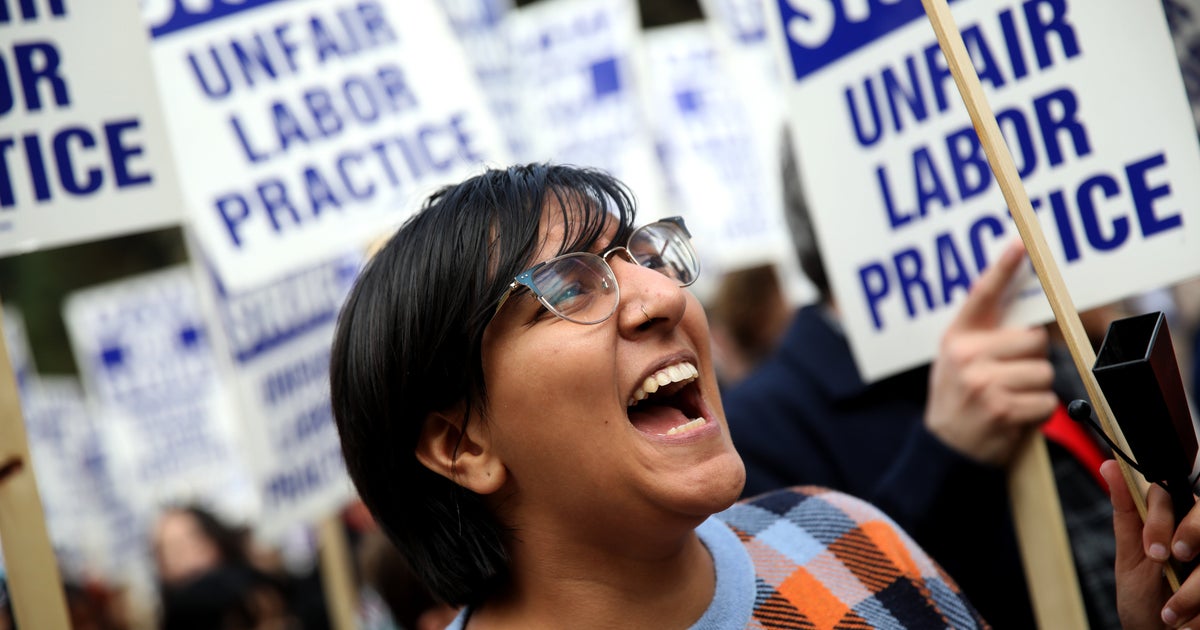
Workers went on strike in growing numbers last year as they took advantage of a tight labor market and pressed employers for better pay and working conditions, two new sets of data suggest.
Figures from the U.S. Bureau of Labor Statistics released Wednesday show nearly 121,000 workers took part in 23 large strikes that began in 2022. That’s up from 81,000 workers taking part in 16 large work stoppages in 2021. The bureau defines a “large” work stoppage as one involving at least a thousand employees.
Meanwhile, a more detailed study from the Cornell University School of Industrial and Labor Relations identified at least 424 work stoppages of all sizes last year, up from 279 the previous year, or a 52% increase. The work stoppages involved at least 224,000 workers, up from 140,000 in 2021, or a 60% jump.
Both the BLS and Cornell data include lockouts — that’s when employers force workers off the job amid a labor dispute, as opposed to the workers walking out by choice. But the lockouts represented a tiny share of the overall work stoppages (just seven of the 424 that Cornell found), and all of the large work stoppages in the BLS findings were strikes.
“Overall, most of the employees involved in last year’s strikes — a whopping 60% — work in education.”
Unemployment hovered at historically low levels last year, which made it harder for employers to find workers and gave employees more leverage to demand improvements to their jobs.
But even though strike numbers increased last year, far fewer U.S. workers go on strike now than decades ago, in large part because of labor unions’ shrinking footprint in the economy. Workers with union protections are far more likely to walk off the job to improve their working conditions, and only 1 in 10 U.S. workers now belong to a union, compared to an estimated 1 in 3 in the 1950s.
“While we documented an uptick in strikes and approximate number of workers on strike in 2022 as compared with 2021, the level of strike activity is lower than earlier historical eras,” the Cornell researchers noted.
The sector that saw the most strikes last year was food and accommodations, which accounted for 34% of all work stoppages, according to Cornell. The bulk of those strikes were small and short, involving either Starbucks workers who have mounted a historic organizing campaign with the union Workers United over the past year, or fast-food workers affiliated with the Fight for $15 campaign.
Overall, most of the employees involved in last year’s strikes — a whopping 60% — work in education. Those strikes tended to be larger and longer than the walkouts in the food industry. More than 135,000 education workers were out a total of 2.5 million strike days, according to the Cornell study.
MediaNews Group/Los Angeles Daily News via Getty Images via Getty Images
The largest strike last year was at the University of California system, where 48,000 teaching assistants, graduate student researchers, postdoctoral fellows and other academic workers walked off the job for 40 days. Believed to be the largest higher-education strike in U.S. history, it ended in December with an agreement between the university and the United Auto Workers union that raised pay as much as 80% for some workers.
Cornell researchers also analyzed the stated reasons for workers going on strike, finding that the most common demands included “better pay, improved health and safety, and more staffing.” An increasing number of workers also called for an “end to anti-union retaliation” and the reinstatement of fired workers.
The Supreme Court recently heard a case that could weaken workers’ ability to strike by opening unions up to lawsuits by struck employers. As HuffPost recently reported, that could make workers less likely to go on strike in the first place if they know companies might be able to pursue damages associated with the work stoppage through litigation.
The Economic Policy Institute, a left-leaning think tank, warned Wednesday in an analysis on strike data that a ruling in employers’ favor could have a devastating impact for workers.
“If the Supreme Court is persuaded by this argument, it will upend decades of precedent surrounding the right to strike and leave workers with a significantly diminished ability to strike,” the authors wrote.
A decision in the case is expected later this year.


Be the first to comment